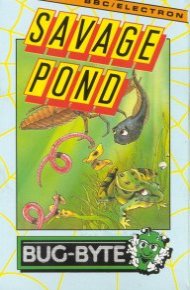Savage Pond
| Savage Pond | |
|---|---|

Cover art of Savage Pond reissue
|
|
| Developer(s) | Gwyll Jones Peter Judd |
| Publisher(s) | Argus Press |
| Platform(s) | Acorn Electron Atari 8-bit BBC Micro C64 |
| Release | 1983 |
| Genre(s) | Arcade |
| Mode(s) | Single-player |
Savage Pond is an arcade-style pond simulation game which was written by Peter Judd for the Acorn Electron and BBC Micro and Gwyll Jones for the 16k versions of the Atari 8-bit family of home computers in 1983 and the Commodore 64 in 1984. It was originally released under the Starcade label and was reissued in 1985 when Argus acquired the Bug-Byte budget label.
The game is set in a pond with the player taking the role of a tadpole. The aim of the game is to build up a colony of frogs while avoiding the many hazards. The setting and characters are all quite true to life which was quite unique at the time. Most contemporary arcade games, even if not set in space, such as Frogger (with frogs that can't swim) and Centipede (which is basically a space shoot 'em up with characters that look like insects), were far from realistic. The instructions include descriptions of all the 'cast' including their Latin names and information not relevant to the game itself. Although it may appear to be an educational game it is actually a fast-paced arcade game.
The game begins with Colony 1, which is a simple, peaceful pond. The tadpole character can swim around the pond eating amoeba. The only hazard in the pond are the hydra clinging to the bottom of the pond that will sting and kill the tadpole if they touch. There is also a dragonfly that occasionally flies over the pond and drops an egg. The egg can be eaten but if left to hatch, the larva will escape (but again can be eaten) and return as a nymph which will chase the tadpole until it catches and eats it or becomes exhausted and leaves to chrysalise and become another dragonfly. In order to build the frog colony, many 'evolutions' must take place, most of which increase the number of hazards. Blood worms regularly fall into the water and must be collected. After five worms are eaten, a beetle larva appears. If this is eaten quickly, the pond 'evolves'. In Colony 1 this means the introduction of jellyfish (similar to the hydra but stay at the top of the pond), the dumping of radioactive waste (which leaves the sides and bed of the pond deadly) and finally a move to Colony 2. This begins with the same hazards as Colony 1 but with a more complicated pond with an underwater cave area which makes swimming about more difficult. The pond continues to 'evolve', first with the appearance of your first frog. This sits on a log and can be used to eat the passing dragonflies. It also acts as an extra life as if all three tadpoles are lost, the frog will reproduce before leaving with its mate for a different colony. You must create another frog before the pond can continue to 'evolve'. Further 'evolutions' include the water spider (which can trap the tadpole with its web line) and water fleas which can eat your spawn (spare lives). Colony 3 adds bumble bees which have apparently been affected by the radiation so attack your frog (in the only real exception to the true to life use of the rest of the creatures in the game). You can now build up a colony of frogs.
...
Wikipedia
